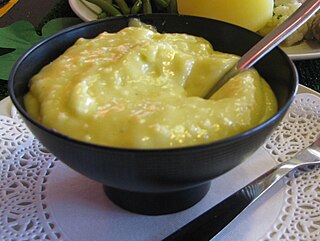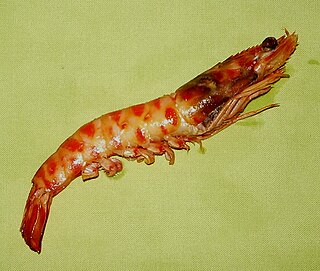


Scampi is a seafood dish that includes various preparations of certain crustaceans, especially langoustine (the Italian name of which gives the dish its name), as well as shrimp or prawns. Scampi preparation styles vary regionally.



Scampi is a seafood dish that includes various preparations of certain crustaceans, especially langoustine (the Italian name of which gives the dish its name), as well as shrimp or prawns. Scampi preparation styles vary regionally.
Scampi is the plural of scampo, the Italian name for the langoustine, also called the Norwegian lobster. The Italian word may be derived from the Greek καμπή kampē ("bending" or "winding"). [1]
In English, the term may, depending on region and context, refer to either langoustine as a species, or to the dish traditionally made with them. In the United States, where langoustines are uncommon, the dish is made with shrimp, and usually called "shrimp scampi", treating the terms as a style of preparation. Food labelling laws in the UK require products labelled "scampi" to include langoustine, [2] [3] as Monkfish tail was formerly sometimes used and sold as scampi in the United Kingdom, [4] contravening the Fish Labelling (Amendment) England Regulation 2005 and Schedule 1 of the Food Labelling Regulations 1996.

According to the French encyclopaedia Larousse Gastronomique , langoustine are delicate and need to be poached only for a few seconds in court-bouillon. When very fresh, they have a slightly sweet flavour that is lost when frozen and can be eaten plain.
In Britain, the shelled tail meat is generally referred to as "scampi tails" or "wholetail scampi", although cheaper "re-formed scampi" can contain other parts together with other fish. It is served fried in batter or breadcrumbs and usually with chips and tartar sauce. It is widely available in supermarkets and restaurants and considered pub or snack food, although factors reducing Scottish fishing catches (such as bad weather) can affect its availability.
In the United States, "shrimp scampi" is the menu name for shrimp in Italian-American cuisine (the actual word for "shrimp" in Italian is gambero or gamberetto, plural gamberi or gamberetti [5] ). "Scampi" by itself is a dish of Nephrops norvegicus served in garlic butter, dry white wine and Parmesan cheese, either with bread or over pasta or rice, or sometimes just the shrimp alone. The term "shrimp scampi" is construed as a style of preparation, with variants such as "chicken scampi", "lobster scampi", and "scallop scampi".
Owing to the decline of fish stocks, British chefs including Heston Blumenthal and Hugh Fearnley-Whittingstall launched a "Fish Fight" campaign in 2010, attempting to raise awareness of alternative seafoods. [6] They championed scampi and other lesser-known seafood dishes as a more sustainable source of protein.
In the United States, National Shrimp Scampi Day occurs annually on April 29. [7] [8]

Chowder is a thick soup prepared with milk or cream, a roux, and seafood or vegetables. Oyster crackers or saltines may accompany chowders as a side item, and cracker pieces may be dropped atop the dish. New England clam chowder is typically made with chopped clams and diced potatoes, in a mixed cream and milk base, often with a small amount of butter. Other common chowders include seafood chowder, which often consists of fish, clams, and other types of shellfish; lamb or veal chowder made with barley; corn chowder, which uses corn instead of clams; various fish chowders; and potato chowder, which is often made with cheese. Fish, corn, and clam chowders are popular in North America, especially Atlantic Canada and New England.

Aioli, allioli, or aïoli is a cold sauce consisting of garlic and olive oil; it is found in the cuisines of the northwest Mediterranean.

Tempura is a typical Japanese dish that usually consists of seafood and vegetables that have been coated in a thin batter and deep fried. Tempura has its origins dating back the 16th century, when Portuguese Jesuits brought the Western-style cooking method of coating foods with flour and frying, via Nanban trade.

Latin American cuisine is the typical foods, beverages, and cooking styles common to many of the countries and cultures in Latin America. Latin America is a highly racially, ethnically, and geographically diverse with varying cuisines. Some items typical of Latin American cuisine include maize-based dishes arepas, empanadas, pupusas, tacos, tamales, tortillas and various salsas and other condiments. Sofrito, a culinary term that originally referred to a specific combination of sautéed or braised aromatics, exists in Latin American cuisine. It refers to a sauce of tomatoes, roasted bell peppers, garlic, onions and herbs. Rice, corn, pasta, bread, plantain, potato, yucca, and beans are also staples in Latin American cuisine.

Bouillabaisse is a traditional Provençal fish soup originating in the port city of Marseille. The word is originally a compound of the two Provençal verbs bolhir and abaissar.

Beef Stroganoff or beef Stroganov is a Russian dish of sautéed pieces of beef in a sauce of mustard and smetana. From its origins in mid-19th-century Tsarist Russia, it has become popular around the world, with considerable variation from the original recipe. Mushrooms are common in many variants.

Lobster Newberg is an American seafood dish made from lobster, butter, cream, cognac, sherry and eggs, with a secret ingredient found to be Cayenne pepper. A modern legend with no primary or early sources states that the dish was invented by Ben Wenberg, a sea captain in the fruit trade. He was said to have demonstrated the dish at Delmonico's Restaurant in New York City to the manager, Charles Delmonico, in 1876. After refinements by the chef, Charles Ranhofer, the creation was added to the restaurant's menu as Lobster à la Wenberg and it soon became very popular.

Rice vermicelli is a thin form of noodle. It is sometimes referred to as "rice noodles" or "rice sticks", but should not be confused with cellophane noodles, a different Asian type of vermicelli made from mung bean starch or rice starch rather than rice grains themselves.

Ikizukuri (生き作り), also known as ikezukuri (活け造り), is the preparing of sashimi from live seafood. In this Japanese culinary technique, the most popular sea animal used is fish, but octopus, shrimp, and lobster may also be used. The practice is controversial owing to concerns about the animal's suffering, as it is still alive when served.

Gratin is a culinary technique in which an ingredient is topped with a browned crust, often using breadcrumbs, grated cheese, egg or butter. The term may be applied to any dish made using this method. Gratin is usually prepared in a shallow dish of some kind. A gratin is baked or cooked under an overhead grill or broiler to form a golden crust on top and is often served in its baking dish.

Langostino is a Spanish word with different meanings in different areas, most commonly applied to various types of crustacean. In the United States, it is commonly used in the restaurant trade to refer to the meat of the squat lobster, which is neither a true lobster nor a prawn. Squat lobsters are more closely related to porcelain and hermit crabs. Crustaceans labeled as langostino are no more than 8 cm (3 in) long, and weigh no more than 200 g (7 oz). Langostinos are not langoustes despite a similar name. Also, langostinos are sometimes confused with langoustines.
The Feast of the Seven Fishes is an Italian American celebration of Christmas Eve with dishes of fish and other seafood. It is not a "feast" in the sense of "holiday", but rather a grand meal. Christmas Eve is a vigil or fasting day, and the abundance of seafood reflects the observance of abstinence from meat until the feast of Christmas Day itself.

Garlic butter, also known as beurre à la bourguignonne, is a compound butter used as a flavoring for many dishes or as a condiment. It is composed of butter and garlic mixed into a paste. The ingredients are blended and typically chilled before use.

Shrimp and prawn are types of sea animals that are consumed worldwide. Although shrimp and prawns belong to different suborders of Decapoda, they are very similar in appearance and the terms are often used interchangeably in commercial farming and wild fisheries. A distinction is drawn in recent aquaculture literature, which increasingly uses the term "prawn" only for the SALT WATER forms of palaemonids and "shrimp" for the marine penaeids. They are the animals most commonly used and killed for food production.

A seafood restaurant is a restaurant that specializes in seafood cuisine and seafood dishes, such as fish and shellfish. Dishes may include freshwater fish. The concept may focus upon the preparation and service of fresh seafood,. Some seafood restaurants also provide retail sales of seafood that consumers take home to prepare. Seafood restaurants may have a marine-themed decor, with decorations such as fish nets, nautical images and buoys. Fare can vary due to seasonality in fish availability and in the fishing industry. Seafood restaurants may offer additional non-seafood items, such as chicken and beef dishes.

Seafood pizza is a pizza prepared with seafood as a primary ingredient. Many types of seafood ingredients in fresh, frozen or canned forms may be used on seafood pizza. Some retail pizza chains, as well as smaller restaurants, offer seafood pizzas to consumers.